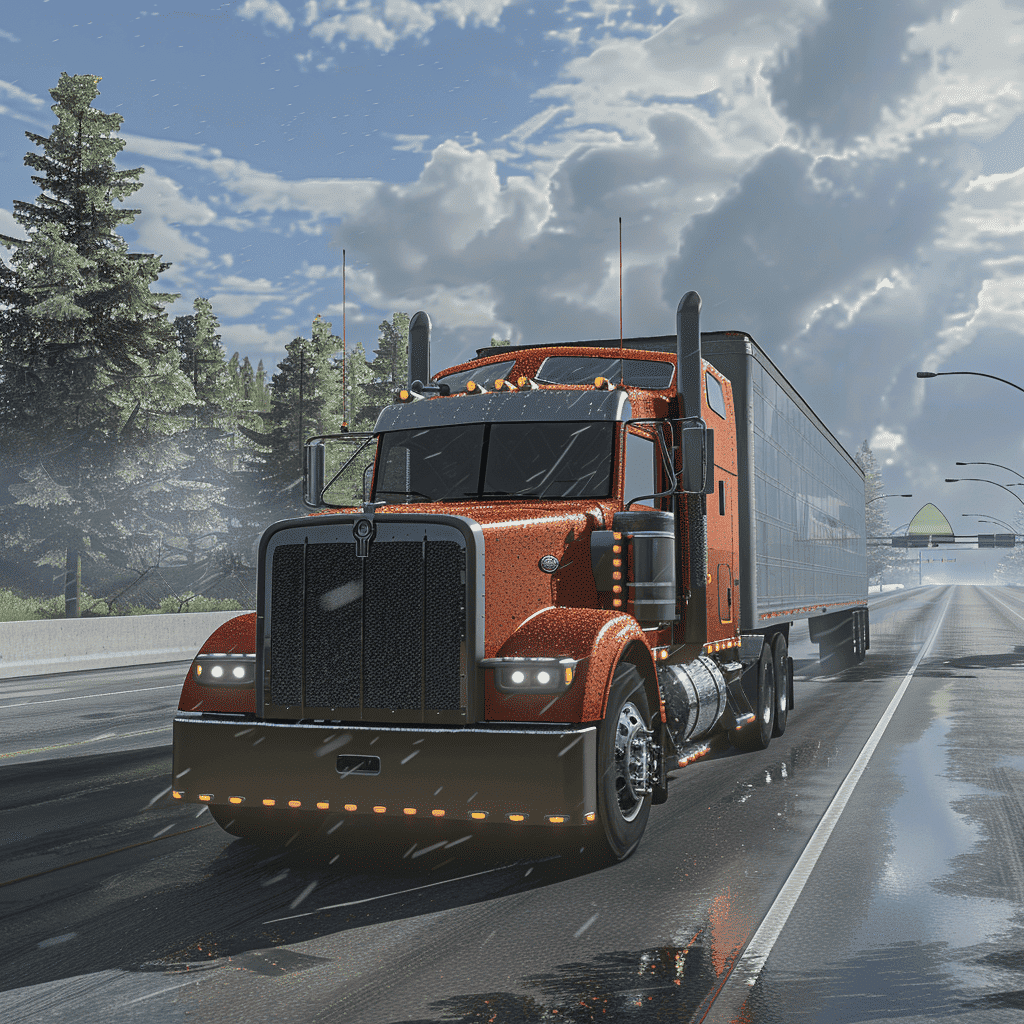Wyoming Truck Weight Limits
Freedom Heavy Haul can offer expedited Pickup and Delivery for any size shipment anywhere in the USA. Contact us today for No Hassle, No Pressure Pricing.
Trucking is a crucial component of Wyoming’s economy, facilitating the efficient transport of goods across the state and beyond. However, to protect roadways and ensure safety, Wyoming, like other states, enforces specific truck weight limits. These regulations not only preserve infrastructure but also ensure the safety of all road users. This article explores into Wyoming truck weight limits, offering a comprehensive guide on legal weight limits, permit requirements, and the impact of these regulations on the trucking industry.
Introduction to Wyoming Truck Weight Limits and Regulations
Understanding the significance of truck weight limits is essential for anyone involved in the trucking industry. These regulations are not arbitrary but are designed to mitigate road damage and enhance safety. Wyoming’s strategic approach to managing truck weight reflects a balance between facilitating commerce and protecting infrastructure.
Significance of Weight Limits for Road Safety and Infrastructure
Heavy trucks can cause significant wear and tear on road surfaces, leading to potholes, cracks, and other damages that can be costly to repair and dangerous for all road users. Weight limits help in reducing these damages, extending the lifespan of roadways, and maintaining safety standards. By complying with Wyoming’s weight regulations, trucking companies can ensure their operations contribute to road safety and infrastructure longevity.
Overview of Wyoming’s Approach to Truck Weight Management
Wyoming’s Department of Transportation (WYDOT) plays a pivotal role in setting and enforcing truck weight limits. The state’s regulations are designed to accommodate the needs of the trucking industry while protecting roads and ensuring safety. By partnering with reliable heavy haul services in Wyoming, you can navigate these requirements with ease and confidence.
Legal Weight Limits in Wyoming Without Permits
Wyoming has established specific weight limits for trucks operating without a permit. These limits are based on the number and configuration of axles on a vehicle, a standard approach used across the United States to determine allowable weight.
Standard Weight Limits for Axle Groups
The state specifies maximum weights for single, tandem, and tridem axle groups. For instance, a single axle is limited to 20,000 pounds, a tandem axle group to 34,000 pounds, and a tridem axle group to 42,000 pounds. Trucking companies must ensure their loads are evenly distributed to comply with Wyoming’s axle weight restrictions and prevent potential penalties.
Overview of Gross Vehicle Weight (GVW) Regulations
The Gross Vehicle Weight (GVW) limit in Wyoming without a permit is set at 80,000 pounds. This cap includes the weight of the vehicle, passengers, fuel, and cargo, ensuring that trucks maintain a safe and legal weight for travel across state roads.
Regulations for Overweight Trucking with Permits
For loads exceeding the standard legal limits, Wyoming offers overweight permits. These permits are essential for transporting heavy loads that cannot be easily divided or reduced. Ensuring Safe and Compliant Heavy Haul Transport in Wyoming ensures that all necessary permits are obtained.
Criteria for Overweight Permit Issuance
Obtaining an overweight permit requires adherence to specific criteria, including the demonstration of a need to transport goods exceeding standard weight limits and the inability to divide the load further. The process of securing overweight permits involves submitting details about your cargo and route to ensure safe transport across Wyoming.
Permissible Weight Limits under Special Permits
With a special permit, trucks can operate under higher weight limits, subject to road and bridge capacity. The state may allow weights up to 160,000 pounds based on the configuration and the specific roads used.
Detailed Analysis of 5 Axle Semi Truck Regulations
Five-axle semi-trucks, a common configuration for long-haul trucking, have specific weight and dimension regulations in Wyoming.

State-Specific Gross Weight Limitations
Depending on the road type and truck configuration, Wyoming allows different gross weight limits for 5 axle semi-trucks, typically ranging from 80,000 to 85,500 pounds. Stay compliant with Wyoming’s gross weight limitations for your 5-axle semi-truck operations.
Axle Weight Restrictions for Compliance
Axle weight restrictions are detailed, ensuring that the weight is evenly distributed across the vehicle to prevent road damage and maintain safety.
Dimensional Limitations on Roadways
Wyoming also enforces dimensional limitations, including height, width, and length restrictions, to ensure that vehicles can safely navigate roads and bridges.
Comprehensive Guide to Overweight Permits
Obtaining an overweight permit in Wyoming is a straightforward process designed to ensure that all necessary precautions are taken to protect infrastructure and maintain safety.
Procedure for Obtaining Overweight Permits
Applicants must submit detailed information about their vehicle and load, including weight, dimensions, and intended route, to WYDOT for evaluation.

Documentation and Compliance Requirements
Required documentation typically includes vehicle registration, proof of insurance, and a detailed load description. Compliance with permit conditions is strictly enforced to ensure road safety.
Impact of Overweight Permits on Route Planning
Permit conditions may restrict the routes overweight vehicles can take, often avoiding roads with vulnerable infrastructure or those that are heavily trafficked.
Special Provisions and Considererations and Considerations
Understanding the nuances of weight regulations is crucial for truckers and trucking companies to navigate Wyoming’s roads legally and safely.

Impact of Tire Width and Axle Spacing on Weight Limits
Tire width and axle spacing are significant factors in determining a vehicle’s weight limit. These parameters influence how weight is distributed across the road surface, affecting both safety and infrastructure wear.
Variable Weight Limits Based on Infrastructure and Season
Wyoming may adjust weight limits based on the condition of the infrastructure or seasonally to prevent road damage during times of vulnerability, such as the spring thaw when roads are more susceptible to damage. Adapting to seasonal weight limit changes is essential for maintaining compliance during specific times of the year.
Weight Limit Enforcement and Compliance
Compliance with weight limits is enforced rigorously in Wyoming to protect roadways and ensure safety. The state employs various methods to catch violators and encourages adherence through penalties.
Methods of Weight Limit Enforcement in Wyoming
Wyoming uses weigh stations, portable scales, and roadside inspections as part of its enforcement strategy. These measures help identify overweight vehicles and ensure compliance with state regulations. Understanding enforcement methods can help you avoid fines and ensure a smooth transport experience.
Consequences of Failing to Comply with Weight Regulations
Violations of weight limits can result in fines, penalties, and even impoundment of the vehicle. These consequences emphasize the importance of adherence to weight regulations for all truck operators.
Strategic Planning for Trucking Operations
For trucking companies and independent operators, strategic planning is key to navigating weight regulations efficiently and effectively.
Optimizing Routes for Weight Limit Compliance
Route optimization software and careful planning can help operators select paths that comply with weight limits while minimizing travel time and costs.
Best Practices for Load Management and Distribution
Proper load management and distribution are essential for compliance with weight limits. This includes evenly distributing cargo across the vehicle to avoid overloading axles.
Impact of Weight Limits on Trucking Industry
Weight limits have a significant impact on the trucking industry, influencing operational costs, vehicle design, and shipping efficiency.
Economic Implications of Weight Limit Regulations
Weight regulations can affect the bottom line of trucking companies by limiting the amount of cargo that can be transported in a single trip and necessitating special permits for heavier loads.
Technological Advances in Truck Weight Management
The trucking industry continues to innovate, developing technologies like air suspension systems and weight distribution products to comply with weight regulations while maximizing cargo capacity.
Conclusion
Wyoming’s truck weight limits play a critical role in protecting the state’s infrastructure and ensuring road safety. Adherence to these regulations is essential for the trucking industry to operate effectively within the state. As regulations evolve and technology advances, ensuring safe and compliant heavy haul transport will continue to meet the needs of modern transportation, ensuring your cargo is delivered safely and legally.







